Aggravated and Mitigated Factors in Sentencing
What are Aggravated Factors in Sentencing?
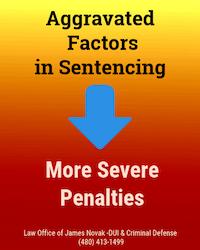
Aggravated factors are those circumstances that make a crime more serious. In turn, the penalties imposed are more severe for the conviction.
Aggravated and mitigated factors in sentencing are recognized at both the Federal level under Title 18 U.S. Code 3592, and the state level under A.R.S. 13-701. The court may also consider aggravated circumstances not listed under law if they are relevant and apply.
Under Arizona Criminal Code Sentencing Provisions, penalties for a conviction are based upon the classification of the charges. Each classification has a sentencing range of categories from less severe to more severe penalties. For example, non-dangerous crime sentencing includes mitigated, minimum, presumptive, maximums and aggravated penalties.
For dangerous offenses, the levels within the sentencing range include minimum, presumptive, and maximum penalties. The penalties within these ranges are inherently higher than the non-dangerous offenses.
If the court finds that the aggravating circumstances surrounded the offense, it will weigh those against any mitigating circumstances presented by the defense. Absent mitigating factors, the judge will decide if additional penalties or aggravated sentencing will be imposed.
In some cases an aggravated factor will call for increased penalties such as maximum penalties, verses aggravated sentencing.
In order for the court to impose aggravated sentencing, it usually requires at least two aggravated factors to have been involved with the offense.
What are the Aggravated Factors Under Arizona Law?
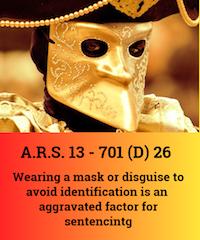
As of August 3, 2018 Arizona criminal code now has 27 statutory aggravated factors under A.R.S. 13-701. (D) J.
The newest one, HB2007, makes it an aggravated factor to use a disguise or mask to hide one’s face before, during, or after committing a criminal offense in an effort to avoid identification.
Below are the remaining 26 statutory factors listed under Arizona Criminal code:
- Causing or threating to cause severe injury to a victim, unless this factor is already being used to impose dangerous offender sentencing.
- The value of that property unlawfully damaged or taken.
- The crime involved an accessory or accomplice.
- The crime was particularly ruthless, or cruel; or a showing can be made that the defendant intentionally caused serious physical harm, pain, or suffering.
- The crime was committed in return for, or the expectation of receiving something of financial value or gain.
- The person was hired to commit the crime.
- The defendant was a federal state or local official or employed or elected to serve the public and committed an offense that directly involved the official duties of that job or appointment.
- The victim died as a result of the defendant’s actions, and the victim’s family suffered as a result of their loss.
- An unborn child died as a result of, and in the process of the crime.
- The defendant had a prior felony conviction within 10 years of the current offense.
- The defendant was wearing body armor described under Arizona law as any type of clothing designed to minimize the possibility of injury from a deadly weapon.
- Using or possessing, or threating to use a gun or other deadly weapon while committing a criminal offense.
- The victim was 65 years of age or older, or and suffered from a significant physical or mental disability.
- The defendant court appointed fiduciary responsibilities to the victim, and the offense directly involved those obligations.
- The offense was a prejudicial hate crime.
- The defendant was convicted of driving under the influence of alcohol with Blood Alcohol Content (BAC) of 0.15%, or higher, and caused negligent homicide, aggravated assault, manslaughter, second or first degree murder.
- Hiding and waiting to surprisingly attack the victim as part of the felony offense.
- The defendant committed domestic violence and other specific crimes specified by law in the presence of a child.
- The defendant committed the crime in revenge because the victim reported their criminal activity.
- While the crime was being committed, the defendant impersonated a law enforcement officer.
- The defendant was illegally harboring humans at the time of the crime; engaging in human smuggling; eluding inspection; attempting to enter the U.S. through means of providing false information; reentered the U.S. after being removed for statutory reasons; or engaged in importation of humans for immoral and illegal purposes such as prostitution.
- A remote stun gun as defined by law was used in the offense.
- A hit and run resulting in serious injury or death of a victim, took place in the process, just prior, or soon after the crime was committed, as a result of the criminal activity.
- The defendant engaged in sex trafficking, child trafficking, or trafficking of persons for the purpose of forced labor, and the defendant lured the victim from a safe house for children or the homeless including domestic violence and assault victims.
- The defendant convicted of aggravated assault against a law enforcement officer, and evidence substantiated the offense as a hate crime against police.
- Other circumstances that the court deems pertinent based on the defendant’s character, history, or other relevant facts.
Note: Capital cases involving potential life in prison or the death penalty with regard to consideration of aggravated and mitigating factors are subject to varied guidelines and jury instructions.
Who Decides if Aggravated Sentencing will be Imposed?
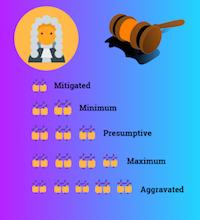
The presiding judge decides whether or not aggravated sentencing will be imposed. The judge has the authority to decide what penalties to impose within a statutory sentencing range based on the circumstances surrounding the conviction.
The judge’s decision is based on a number of factors. These include but are not limited to the nature of the crime, whether it was dangerous or non-dangerous, whether aggravated or mitigating circumstances were involved, prior convictions, repeat offense, and whether or not the crime involved a victim.
When both aggravated and mitigating factors are involved, the judge will weigh them against each other to determine what penalties will be imposed within the sentencing range.
Below is a sample case of facts where aggravated factors would likely call for aggravated sentencing in a felony case:
Example: The defendant was convicted theft of an item that exceeded $25,000.00. He was charged with a first time, non-dangerous class 2 felony offense.
Evidence indicated that defendant wore a mask to hide his identity.
While fleeing the scene of the crime, the defendant committed a hit and run. The defendant failed to stop or to provide vehicle registration, insurance, and identifying information, or to find out if the driver was in need of emergency assistance.
The defendant was found guilty at trial.
No mitigated factors were presented.
In this case at least two aggravated factors surrounded the offense. If no aggravated factors had been involved, a presumptive sentence of 5 years prison would have applied. However, since two aggravated factors existed, and no mitigating factors were presented, the judge imposed aggravated sentencing of 12.5 years.
What Standard of Proof is Required for Aggravated Factors to be Used?
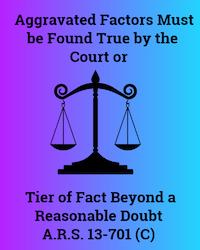
Both the United States Supreme Court and Arizona Supreme Court have long held that the standard of proof to be considered for aggravated factors is evidence beyond a reasonable doubt.
Under Arizona criminal code, A.R.S. 13-701 –(C) & (D), the standard of proof is proof for the first aggravated factor is “beyond a reasonable doubt” that the aggravated circumstance took place. However, the court may find additional factors by using the standard of “preponderance of the evidence.”
The exceptions are 1) If the defendant admitted to the aggravated factor, and 2) if it deals with a prior felony, the court will decide this this based on the facts presented.
If no mitigating factors have been presented to weigh against aggravating factors, the presiding judge will decide whether or not to impose an aggravated sentence if two or more exist.
What are Mitigating Factors in Sentencing?
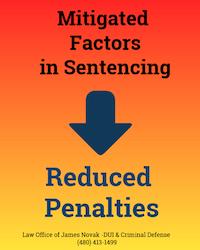
Mitigating circumstances are those factors that serve to reduce the sentencing consequences of a crime. The court will weigh mitigating factors against aggravated factors. If at least two mitigating factors existed, and no aggravated factors were involved, the judge will generally impose a mitigated sentence.
Under A.R.S. 13-701 (E) there are 6 statutory mitigating factors that can be considered for sentencing as follows:
1. The defendant’s age; 2. Culpability or the lack of capability to understand and recognize the unlawful nature of their actions; 3. The defendant acted under duress; 4. The defendant’s involvement in the offense was trivial; 5. In the event of a hit and run, leaving the scene of the accident, or failure to provide required information after an accident, and the defendant later complied. 6. Any other aspect of the defendant’s record, character, or other relevant circumstance not listed under the statute. In order for a mitigating factors found to be considered it must be found true by the court based on the evidence presented in the case.
Below is a sample case of how a mitigating factor can impact sentencing:
Example: The defendant was found guilty of being an accomplice in an armed robbery and convicted of a class 2 dangerous felony.
Her boyfriend committed the armed robbery while she waited in the vehicle.
The defendant’s attorney argued that while the defendant admitted that was aware that a robbery was taking place, she testified that she had no knowledge of his possession of a gun, or his plans to threaten the cashier with it.
Her criminal defense attorney also argued that her involvement was minor and should be considered a mitigating circumstance.
This was the defendant’s first criminal offense.
The minimum sentence for this offense is 7 years, the presumptive sentence for this range is 10.5 years, and aggravated sentence is 21 years in prison.
After considering the mitigated factors of the defendant’s minimal involvement in the crime, and that fact that she had no knowledge that a weapon was used, the judge would likely impose the minimum sentence of 7 years prison.
How can a Criminal Attorney Help Me Resolve My Felony Charges?

If you face felony charges in Arizona, it is serious since all felony offenses call for prison terms, and a felon criminal record that will impact your life for years.
When the conviction involves aggravated factors and sentencing, it becomes even more serious. Your freedom and future are at stake.
For anyone facing felony charges, the ideal outcome is to be able to get your charges dismissed. While this does occasionally happen, the reality is that a majority of felony charges are resolved through negotiated plea agreements in Arizona. For this reason it is important that you hire an attorney with strong negotiation and litigation skills as well as knowledge and experience in all phases of the criminal justice process.
James Novak, of the Law Office of James Novak, PLLC is an experienced felony defense attorney, and former prosecutor with over 20 years of experience in criminal law. He exclusively defends those charged with crimes in Mesa, Tempe, Chandler, Gilbert, Phoenix, and Scottsdale AZ.
James Novak takes felony charges very seriously and understands the impact it has on a person’s life. If retained, he can make sure your rights are protected and defend your charges. Criminal defense attorney James Novak will fight to get you the best possible outcome in your case. James Novak utilizes his strong negotiation skills and looks for strengths in your defense case, as well as weaknesses in the prosecution’s case . If a constitutional and acceptable negotiated agreement cannot be reached you still have the right to take your case to trial.
James Novak will look for, and present mitigating factors to the court to offset aggravated circumstances, as well as challenge any invalid aggravated factors that the prosecution plans to use against you at trial. Criminal Defense Attorney James Novak personally offers a free initial consultation for those facing active criminal or DUI charges in his service area. This includes both felonies and misdemeanors. If you have been charged with a crime contact or call (480) 413-1499 today to learn more about your options for defense and resolving your charges.












